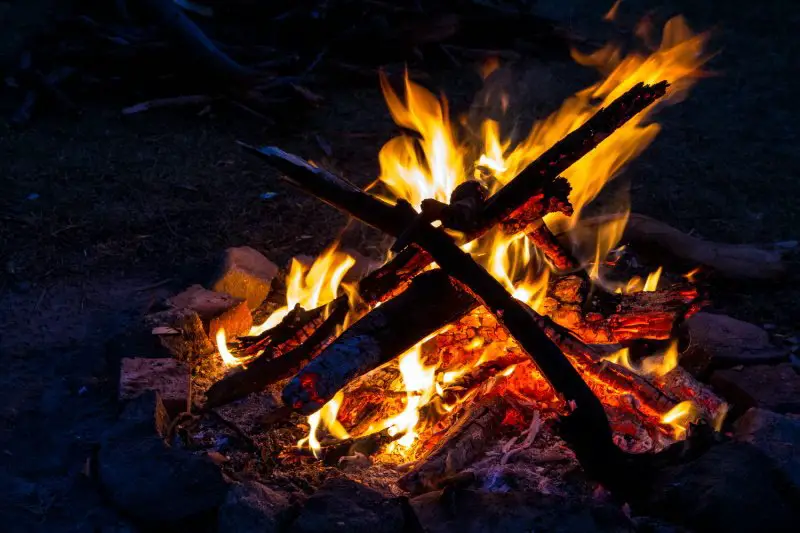
There are two types of change that all matter goes through: physical changes and chemical changes.
A physical change has an effect on a substance’s physical properties, while a chemical change will impact a substance’s chemical properties.
To determine whether wood burning is a physical or chemical change, it is important to understand the properties of physical and chemical changes.
What Is a Physical Change?
A physical change changes a substance’s physical properties.
Often, a physical change can be reversed.
Physical changes include cutting, bending, freezing, evaporating, and more.
For example, when water changes states from a liquid to a solid or a gas, this is a physical change.
Water can be changed to ice and then back to water again by changing the temperature.
Another example is cutting grass.
Although the grass has been cut, it retains the properties that make it grass.
When a substance undergoes a physical change, it retains its original properties.
This includes changes such as breaking a glass, melting ice, dissolving sugar in water, or chopping wood.
What Is a Chemical Change?
A chemical change occurs when two substances interact to form new chemical bonds.
This union results in a new substance, and it cannot return to its original state.
For example, when iron rusts, the rust is a new substance, and this change cannot be undone.
Another example is food rotting; once food rots, it cannot change back to the way it was before.
A chemical change alters the composition of the substance when the two original substances undergo a chemical reaction to become a new substance.
Is Wood Burning a Physical or Chemical Change?
Wood burning is an example of a chemical change.
When you burn wood, the wood mixes with heat and oxygen to transform into carbon dioxide, water vapour, and ash.
Once this change occurs, it cannot be returned to its original state.
Chopping wood, on the other hand, is a physical change.
When you chop wood, you make it smaller, but it still retains the same properties; in other words, it is still wood.
When you understand the differences between physical and chemical changes, it will be easier to identify the type of changes that occur.
Ways to Distinguish Between Physical and Chemical Changes
The easiest way to distinguish between a physical and a chemical change is to understand that the physical change doesn’t change the nature of the substance.
For example, when you chop wood, you can observe that you still have two pieces of wood.
Each may be smaller than the original piece, but its fundamental properties are the same.
When you burn wood, the wood becomes ashes.
It no longer looks or feels like wood, and you can put the ashes together to make a new piece of wood.
This shows you that burning wood has to be a chemical change.
Understanding the Chemical Reaction of Burning Wood
The process of burning wood is also called combustion.
For combustion to occur, you need to combine three substances: fuel, oxygen, and heat, with fuel being wood, gas, or oil.
The way it works is that the wood, which is called the reactant, has energy stored within its chemical bonds.
This energy can be released when these bonds react with the oxygen in the air.
When you heat wood, these small molecules are released from the wood’s surface as gases, and they produce heat when they react with the oxygen.
As the fire burns the wood, the wood releases more molecules that combine with the air, and the ashes are left behind.
What Causes Combustion?
Combustion produces fire, and it requires fuel, oxygen, and heat.
In the case of burning wood, the wood is the fuel, and the air provides the oxygen.
You need enough heat to raise the temperature of wood to its ignition temperature, or the temperature at which combustion occurs.
The heat can come from a match, friction, focused light, or lightning.
The wood needs to be heated to around 300 degrees Fahrenheit before it will combust.
It causes some of the wood to decompose and release volatile gases, which are compounds of hydrogen, carbon, and oxygen.
This is the smoke you see when you burn wood.
What is left of the wood turns to char, which is a combination of carbon and ash.
In fact, when you purchase charcoal, it is made of this product: carbon and ash.
When you burn wood, it actually happens in two separate reactions.
You need to heat the wood to 300 degrees to get smoke, but you need to reach 500 degrees Fahrenheit to get fire.
At this temperature, the compound molecules split apart, and they combine with oxygen to form carbon dioxide, water vapor, and other compounds.
It is these chemical reactions that cause the heat that you feel from the burning wood.
The second reaction is the carbon in the char combining with the oxygen from the air.
This reaction produces water, carbon dioxide, carbon monoxide, carbon, and nitrogen.
It is a much slower reaction, which is why charcoal holds its temperature for long periods of time.
Dangers of Wood Burning
The dangerous thing about wood burning is that it is self perpetuating.
As long as there is fuel and oxygen, the heat will continue to cause the wood to burn.
In addition, it will heat surrounding fuel, such as other wood.
This is why forest fires are so dangerous and spread so easily.
The only way to stop this chemical reaction is to reduce the heat or remove the oxygen that is causing the wood to continue to burn.
Conclusion
Is burning wood is a physical or chemical change?
Once you understand the differences between these two changes, it is clear that it is a chemical change.
A physical change changes the physical properties of a substance, while a chemical change will create a new substance altogether.
When you burn wood, you create a new substance, and it can’t return to its original state.
